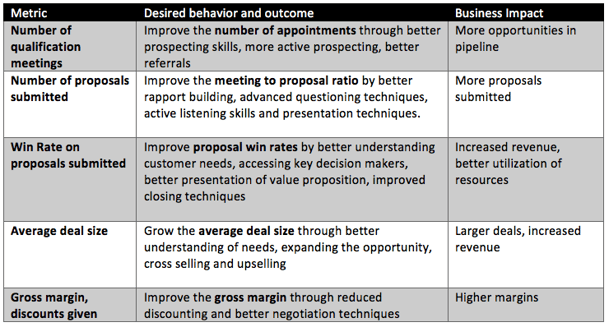Why Sales Training Leads to Better Results, and How to Track It

When we ask our clients about why they're embarking on sales training, we often hear that they "haven’t done it in a while", or because the “leadership team said we needed to.” Typically, it is tied to some goal of wanting to increase sales —but who doesn’t want to increase sales? While this is a valid reason, it is often difficult to determine whether the improved sales results are truly attributed to sales training or other factors. Is there a cause and effect, or is it just coincidence?
Why Sales Training?
To help refine a sales training program, it’s important to break down “the why” in greater detail and define desired outcomes that map to the training objectives. Some of the things you would want to know include:
- What are the gaps in desired performance?
- What does the Sales Executive(s) want the team to do better or differently?
- What outcome are they looking for—what will be different after the training if it’s successful?
- How will they measure the difference?
By better understanding these needs—and getting clear about these objectives for the training—you can better focus the training on skills that will likely make a difference, and structure a program to meet and exceed expectations.
Level Four Measurement: It’s All About Results
While the Kirkpatrick model for evaluating training looks at four levels (Level 1: Reaction, Level 2: Learning, Level 3: Behaviors and Level 4: Results) we find that most programs seem to focus on levels 1, 2, and 3 metrics. Our focus is to measure the training based on Level 4 outcomes and business results. It's important to break down the business results into the key performance indicators that you expect to impact as a result of the training. It’s not enough to set a goal of improving sales as a result of training. We believe the focus should be on determining which behaviors the training is expected to influence and what impact these behaviors will have on sales results.
Below is a sample table of metrics, outcomes, and the business impact of improving or changing specific behaviors.

The Business Impact of Sales Training
Finally, you need to understand and project the impact of changing these metrics on sales performance. Usually, improving any of these factors by a small amount will result in a significant improvement in sales results. Multiply these incremental improvements across the entire sales team and you’ve produced a strong business case. The following questions can be helpful in exploring and modeling the potential outcomes:
What if each sales person on the team:
- had one more qualified meeting per month?
- converted one addition meeting to a proposal per month?
- improved win rate by X%?
- grew average deal size by X%?
- eliminated discounting and improved margins by X %?
Once a few of these metrics are prioritized, it’s critical to benchmark these metrics before training. If there isn’t a scorecard or dashboard in place, this would be a good time to put one together. Otherwise, how will you know if the training has made a difference?
We suggest developing or working with your training partner to create a business case calculator which allows you to enter these variables and produce a projected return on investment based on the cost of the program. Making assumptions and testing the potential outcomes allows you to set a baseline from which to start; and will help you focus the training on the areas that will produce the best results.
